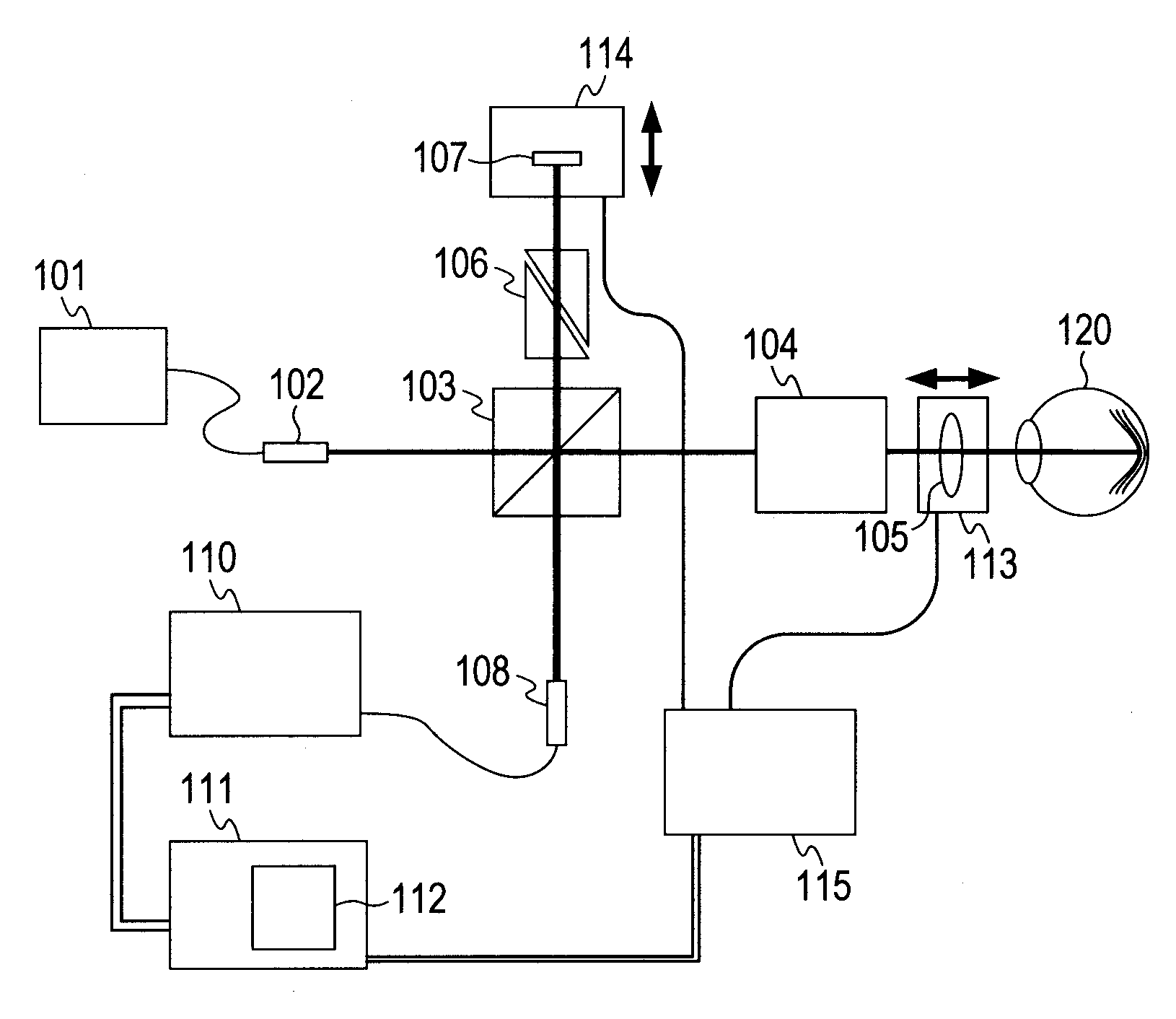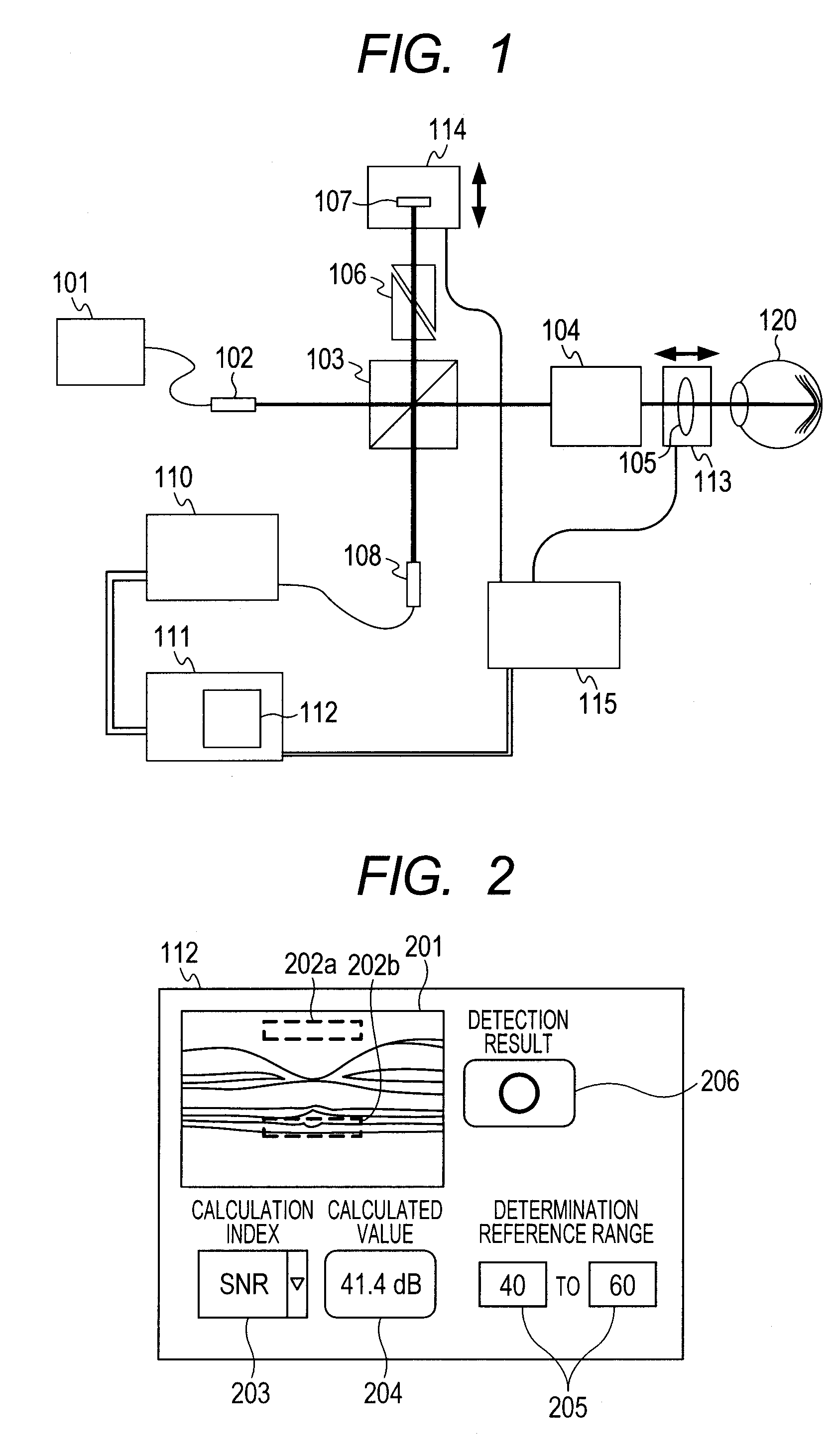Optical tomographic imaging apparatus
a tomographic imaging and optical tomography technology, applied in the field of imaging methods and imaging devices for optical tomographic imaging, can solve the problems of a frame out of the imaging range, a decrease in contrast, etc., and achieve the effects of easy determination, good image quality and improved image quality
- Summary
- Abstract
- Description
- Claims
- Application Information
AI Technical Summary
Benefits of technology
Problems solved by technology
Method used
Image
Examples
example 1
[0027]A specific example is described according to the embodiment illustrated in FIGS. 1 to 4.
[0028]A super luminescent diode (SLD) which has a center wavelength of 840 nm and a wavelength width of 45 nm is used as the low coherence light source 101. The object 120 is the human eye retina. The dispersion compensation glass 106 is made of BK7 glass, and is configured by using two dispersion prisms having a longer side of 20 mm and a shorter side of 15 mm. The longer sides are arranged so as to be parallel with the optical axis, and a standard refractive index liquid is applied to the oblique surfaces so that the oblique surfaces are adhered to each other. The thickness of the glass serving as the optical path can be changed in a range of approximately 20±10 mm by displacing the oblique surfaces.
[0029]The detection unit 110 is configured as described below. The line sensor camera has a pixel size of a 14-μm square, a pixel pitch of 14 μm, the number of pixels of 2048, and a line rate ...
example 2
[0036]This example describes a case in which the calculation index is not SNR and the area designation is different referring to FIGS. 5A to 5C.
[0037]FIG. 5A illustrates a case in which an area 501a near the neuroepithelial layer of retina directly below the central fovea is designated. According to the spectral domain OCT, the signal intensity increases as the position becomes closer to the reference mirror, and the signal intensity thus tends to increase at a neighborhood 502a of the nerve fiber layer. Thus, whether the luminance value in the area 501a is good or not can be determined by designating the area 501a, and setting the calculation index to “Maximum value”. In other words, it is possible to arbitrarily set an area of interest and to easily determine whether the luminance value is high or not.
[0038]FIG. 5B illustrates a case in which a neighborhood 501b of the internal granular layer and a neighborhood 502b of a layer next thereto are designated. In this case, it is possi...
example 3
[0044]This example describes an example of designating an area by a name of a specific portion.
[0045]Though the examples in which the designation is made by a position coordinate in the image display portion 201 are described in the preceding section, there are cases in which an area is designated more conveniently by a name of a specific portion.
[0046]FIG. 6 illustrates a case in which an area is designated by “Nerve fiber layer” (601a), and a case in which an area is designated by “Pigmented layer” (601b). When a lesion is diagnosed using OCT images, a change in a specific portion is often focused upon usually, and the specific portion can be easily designated by the name rather than the position coordinate.
[0047]Each of layers can be discriminated in advance by applying processing of calculating boundaries of each of the layers from image data (segmentation). When the object 120 is the human eye retina, options such as “Nerve fiber layer”, “External granular layer”, “Internal gra...
PUM
 Login to View More
Login to View More Abstract
Description
Claims
Application Information
 Login to View More
Login to View More - R&D
- Intellectual Property
- Life Sciences
- Materials
- Tech Scout
- Unparalleled Data Quality
- Higher Quality Content
- 60% Fewer Hallucinations
Browse by: Latest US Patents, China's latest patents, Technical Efficacy Thesaurus, Application Domain, Technology Topic, Popular Technical Reports.
© 2025 PatSnap. All rights reserved.Legal|Privacy policy|Modern Slavery Act Transparency Statement|Sitemap|About US| Contact US: help@patsnap.com



